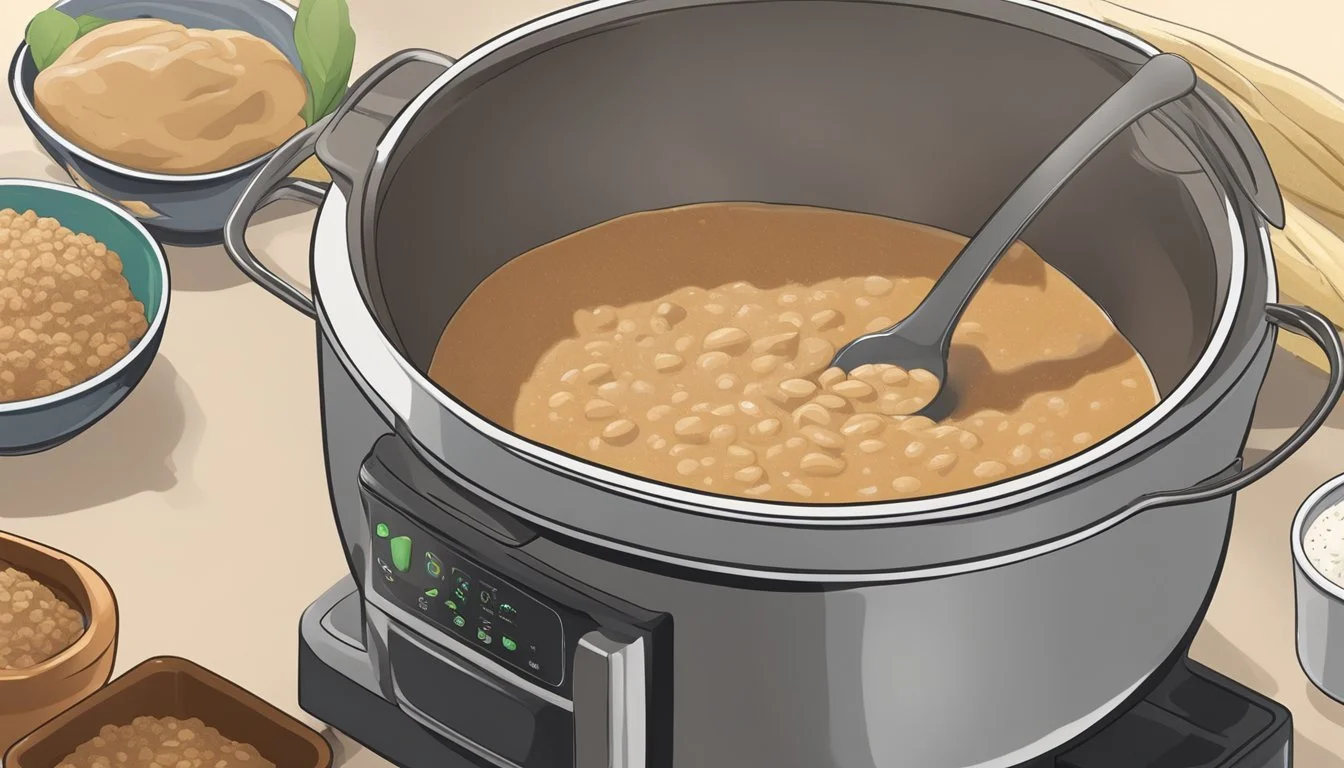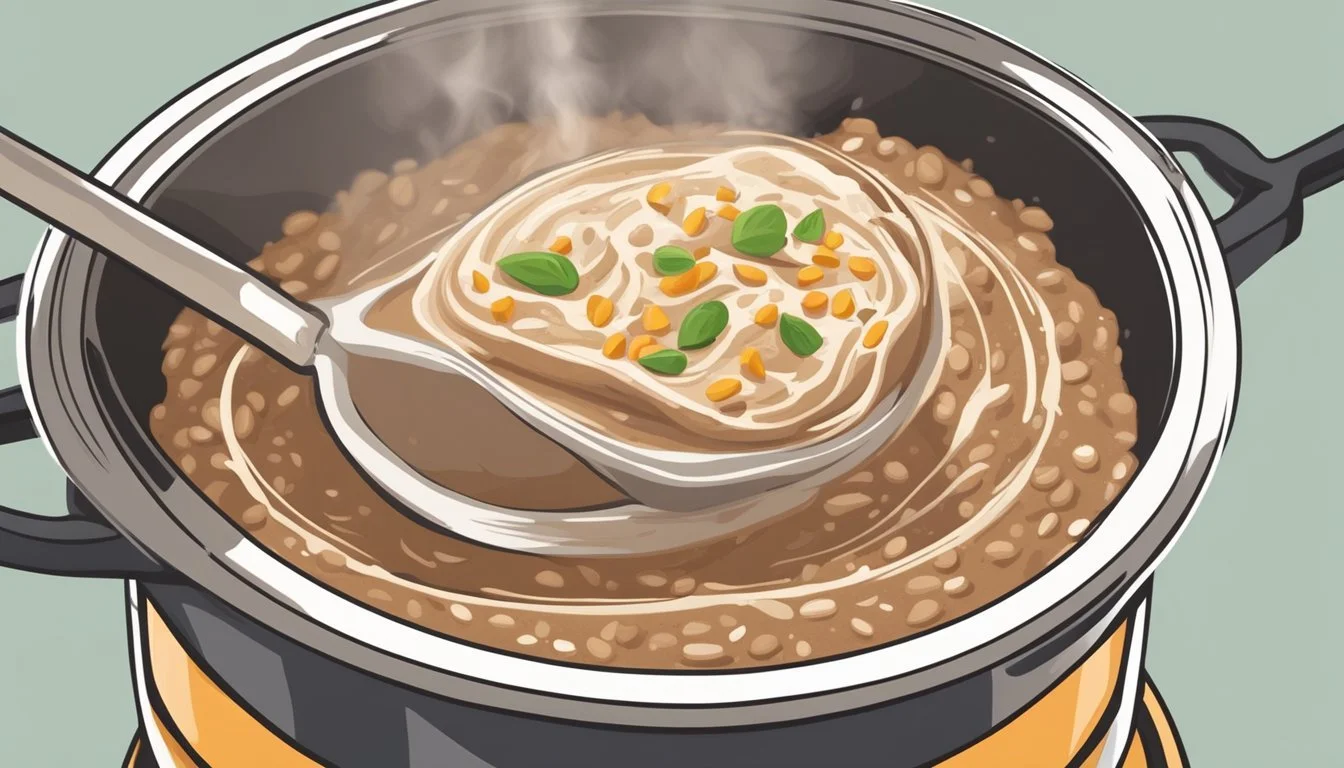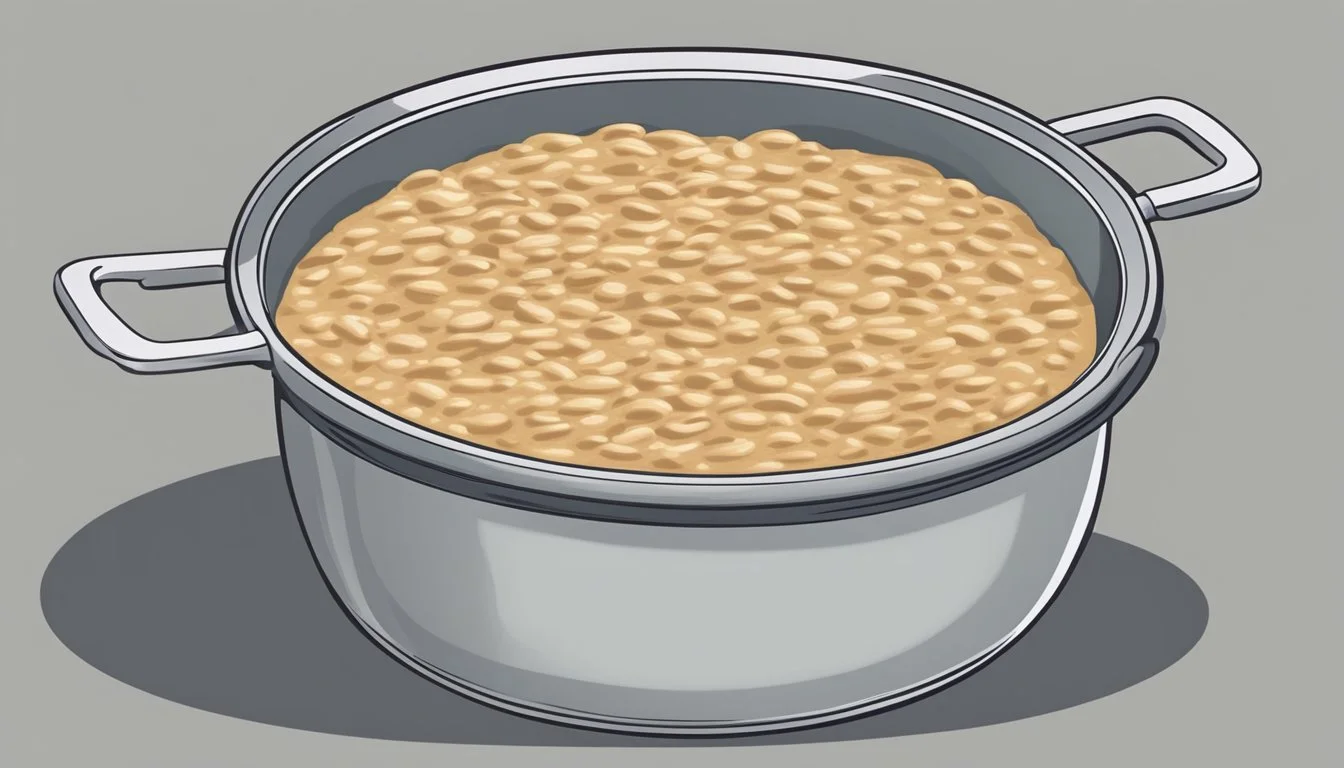Fixing Watery Refried Beans
Master Thickening Techniques for Perfect Burritos and Dips
Refried beans are a staple in Mexican cuisine, often used as a key ingredient in burritos and dips. Achieving the right consistency is crucial for the overall texture and proportion of ingredients in these dishes. When refried beans turn out too watery, they can compromise the integrity of a burrito, causing it to become soggy, or result in a dip that lacks the creamy, hearty quality desired.
To fix watery refried beans, various thickening methods are employed. Cooking the beans for a longer time allows excess liquid to evaporate, which naturally thickens the mixture. For quicker solutions, cooks can incorporate thickening agents like cornstarch, flour, or arrowroot powder, creating a slurry with water before adding to the beans to avoid clumps. Alternatively, instant mashed potatoes serve as a thickener, providing a subtle flavor enhancement while improving the beans' texture.
Proficient cooks know that the success of refried beans lies not just in their flavor but also in their texture. By implementing these techniques, cooks ensure their refried beans reach the optimum consistency, making them an excellent addition to various dishes where a thicker, more substantial component is required.
Understanding Refried Beans
Refried beans are a staple in many cuisines, prized for their creamy texture and versatility. This section delves into the variances in bean types, cooking methods, and nutritional aspects that make refried beans both a delicious and a complex dish.
Types of Beans and Their Textures
Different types of beans can alter the texture and flavor profile of refried beans. Pinto beans are most commonly used for their creamy texture and ability to absorb flavors well. Black beans are also a popular choice, offering a slightly firmer texture and a more pronounced taste. Kidney beans are less traditional, with a meatier texture that isn't typically sought after in refried beans. The key to selecting beans is to consider the desired end texture for the dish they will accompany.
Traditional vs. Modern Cooking Methods
Refrying, in traditional cooking methods, refers to the process of cooking boiled beans in fat—often lard—to achieve the authentic flavor and creamy consistency. Today's techniques vary, with many dishes being referred to as "refried beans" even when they've been baked or cooked in oils as a healthier or dietary alternative, such as vegan or dairy-free options. While modern methods may utilize less fat or incorporate non-traditional ingredients, true refried beans are cooked twice, with the second cooking phase in fat being crucial to developing the dish's hallmark texture and taste.
Nutritional Profile and Dietary Considerations
Refried beans can be a healthy addition to a diet, being high in fiber and protein while being naturally gluten-free. Traditional recipes may include lard, making them unsuitable for a vegetarian or vegan diet, but many modern interpretations adapt the recipe to be vegan-friendly by using plant-based oils instead. The nutritional content largely depends on the ingredients and cooking techniques used, with the potential for high sodium or fat content if not prepared with health considerations in mind.
Preparations Before Thickening
To ensure the desired outcome in thickening refried beans, the preparatory steps are crucial. They lay the foundation for the beans' texture, a key component for flavorful burritos and dips.
Selecting Quality Beans
Choosing quality beans is the first step to achieving the perfect consistency. One should opt for pinto or black beans as they are traditionally used for refried beans. For those preferring convenience, canned beans may be used, but it's essential to check for firmness and freshness. If using dry beans, ensure they are properly sorted and cleaned. A preliminary soak of dry beans is recommended to reduce cooking time and enhance texture.
Cooking and Mashing Techniques
Proper cooking is central to the texture of the beans. When using a slow cooker or a pot on the stove, one must cook the beans until they are tender. The bean-cooking liquid should be preserved to adjust consistency during mashing. After cooking, use a potato masher or a hand mixer to mash the beans to a smooth or coarsely mashed texture, depending on preference. Skillet frying can introduce additional flavor, where the beans are further cooked and mashed.
Draining and Consistency Adjustment
Once the beans are cooked and mashed, assess the consistency. If the mixture is watery, draining excess liquid is crucial before any thickening techniques are applied. For beans that are too dry, add the reserved bean-cooking liquid in small increments. The objective is to reach a thick, spreadable texture that is neither too runny nor overly stiff.
By meticulously following these preparatory steps, one paves the way for successfully thickening refried beans to the perfect consistency for burritos and dips.
Thickening Techniques for Watery Refried Beans
When refried beans turn out too watery, they can be easily thickened to achieve the desired creamy texture suitable for burritos and dips using various ingredients ranging from starches to dairy products.
Starch-Based Thickening Agents
Starch-based thickeners are a reliable way to achieve the perfect consistency in refried beans. For immediate results, one can create a slurry by mixing equal parts of cornstarch, all-purpose flour, or arrowroot powder with water, and then gradually stirring the mixture into the simmering beans. Heating the beans for an additional few minutes allows the thickening agents to work effectively, resulting in a creamy and cohesive texture.
Cornstarch: Provides a clear, glossy finish without altering flavor.
All-purpose flour: Adds a slightly earthy note and is often readily available.
Arrowroot powder: A gluten-free option that thickens at a lower temperature.
Vegetable and Legume Additives
For those looking for a natural thickening method, additional vegetables and legumes can enhance the beans' texture and nutritional value. One can puree extra beans and incorporate them into the mix for a fiber-rich thickener. Onion and garlic, when finely minced and sautéed until soft, not only improve the flavor but also contribute to the overall thickness. Alternatively, potato flakes are a quick and efficient thickener; a small quantity stirred into hot beans will absorb excess moisture and thicken the mixture within minutes.
Extra beans: Mash and blend back into the pot for an all-bean thickener.
Potato flakes: Act fast and deliver a consistent thickening effect.
Dairy and Dairy-Alternative Methods
Incorporating dairy or its alternatives presents a rich and flavor-enhancing method to thicken refried beans. Cheese, particularly shredded cheddar, melts into the beans, providing both a creamy texture and a tangy taste. Small blocks of cream cheese or dollops of sour cream can be stirred in for a tangy richness, while a splash of milk or heavy cream can offer a subtle creaminess. These additions should be done towards the end of heating to prevent the dairy from curdling.
Cheese (Cheddar): Yields a creamy consistency and rich flavor.
Sour cream / Cream cheese: Introduces a slight tang and smooth texture.
Milk / Heavy cream: Adds a light creaminess and can soften the beans' taste.
Enhancing Flavor and Texture
When fixing watery refried beans for burritos and dips, it's crucial to not only achieve the desired consistency but also to enhance the beans' flavor and texture. This section outlines effective methods to intensify the taste profile and refine the texture of refried beans for a truly satisfying culinary experience.
Incorporating Spices and Herbs
To elevate the flavor, spices and herbs play a pivotal role. Classic choices include:
Cumin: Brings a warm and earthy note.
Chili powder: Adds a spicy kick.
Cilantro: Offers a fresh, citrusy depth.
A pinch of salt is fundamental to amplify other flavors.
Frying and Fat Infusions
Frying the beans in a fat source is essential not only for flavor but also for texture. The fats commonly used are:
Oil: Such as vegetable oil for a neutral taste.
Butter: For a richer, creamy flavor.
Frying beans in fat helps to create a more cohesive and less watery consistency.
Accommodating Special Diets
To cater to gluten-free, dairy-free, and vegan diets, appropriate fat sources like oil can be used for frying instead of butter. For thickening, options like masa harina for a corn flavor or gluten-free flour blends work well.
Mix-ins for Enhanced Creaminess
For an extra creamy texture, consider adding mix-ins:
Instant mashed potatoes: A gluten-free option that thickens without altering flavor much.
Sour cream or heavy cream: Adds richness, best for those not following a dairy-free diet.
Incorporating these elements diligently will transform your refried beans into a flavorful and texturally satisfying component of any dish.
Serving and Pairing Suggestions
When it comes to refried beans, the right pairing enhances both flavor and presentation. Refried beans are not only a versatile side dish but also a delicious component in various meals and snacks.
Burritos and Mexican Dishes
Refried beans are a staple in Mexican cuisine, often served as a flavorful layer in burritos. They can be combined with rice, shredded cheese, salsa, and a choice of protein such as beef or chicken within a soft tortilla. For a vegetarian option, one might blend refried beans with roasted vegetables and Pico de Gallo. Additionally, refried beans can fill enchiladas or be served as a side to complement dishes like fajitas and quesadillas.
Dips and Spreads for Snacks
As a dip, refried beans pair exceptionally well with tortilla chips, offering a hearty option for snacking. To elevate the dip, a layer of refried beans can be topped with salsa, sour cream, guacamole, and cheese, creating a vibrant and flavorful seven-layer dip. This dish is perfectly suited for parties or as an appetizer.
Complementing Main Courses
Refried beans are often used to enrich the flavor of main courses. As a side dish, they seamlessly accompany proteins such as grilled steak or chicken. The richness of the beans balances the savory notes of the meat. For those preferring plant-based options, refried beans can be combined with grilled tofu (What wine goes well with grilled tofu?) or seared tempeh. The smooth texture and savory taste of refried beans also make them ideal for serving alongside avocado slices as a nutritious boost.
Preventing and Fixing Common Issues
When crafting the perfect refried beans, controlling the texture is vital. This section addresses techniques to prevent watery beans, correct over-thickening, and manage storage and reheating for the best consistency.
Avoiding Watery Outcomes
One must attentively manage the cooking water and cooking time to avoid watery refried beans. To prevent excess liquid, it is essential to:
Drain beans thoroughly after cooking.
Simmer the beans at a low heat to evaporate excess moisture.
Mash the beans while cooking to assess and enhance their thickening.
Remedies for Over-Thickening
If refried beans become overly thick, they can often be corrected without much difficulty. A gentle approach is key:
Gradually stir in milk or cooking water to adjust the texture.
Remember, adding liquid should be done little by little to avoid reversing the issue.
Proper Storage and Reheating
Maintaining desirable texture during storage and reheating is important for refried beans intended for dips and burritos:
Cool refried beans before storing to prevent condensation and additional moisture.
Reheat on a stove, stirring frequently to redistribute warmth and prevent sticking.
For best results, add a small amount of water or milk while reheating to restore texture.
Homemade vs. Canned Refried Beans
Refried beans are a staple in many dishes, yet the dilemma between using homemade or canned refried beans can affect the flavor and texture. Each option offers different advantages and requires various levels of preparation and customization.
Pros and Cons of Each Option
Canned Refried Beans:
Pros:
Quick Convenience: Canned beans are ready to use, offering a time-saving advantage.
Consistent Quality: They provide a consistent taste and texture.
Cons:
Less Authentic: The flavor may not match the authenticity that homemade beans offer.
Limited Customization: There is less room to tweak the flavor profile to personal preferences.
Homemade Refried Beans:
Pros:
Authentic Flavor: Cooking from scratch presents a more authentic taste.
Complete Control: Spices, onions, and garlic can be adjusted to perfect the flavor.
Cons:
Time-Consuming: They require more time to prepare, cook, and mash.
Variable Quality: Homemade beans may lack consistency in texture and flavor.
Improving Canned Refried Beans
Canned refried beans benefit greatly from enhancements. To impart a more authentic taste and improve texture, one could:
Sauté onions and garlic before adding the canned beans to the pan.
Introduce bold spices like cumin or chili powder for depth.
Modify texture by stirring in a small amount of water or broth if they are too thick.
Steps to Making Homemade Refried Beans
The process of making homemade refried beans involves several key steps:
Soaking: Start with dry beans and soak them overnight to soften.
Cooking: Boil the beans until tender, which may take a few hours.
Mashing: Manually mash the beans or use a food processor for a smoother consistency.
Refrying: Cook the mashed beans with fat like lard or oil, adding in desired onions, garlic, and spices to tailor to one’s taste.
Creating homemade refried beans allows for a richer, more customized base for burritos, dips, and other dishes, although it is more time-intensive compared to the ease of using canned beans.
Final Thoughts
When tackling the issue of watery refried beans, chefs have at their disposal a variety of thickening techniques that ensure those beans reach the desired creamy consistency. Whether preparing a burrito or crafting a dip, the end goal is to achieve a dish that offers both substance and satisfying flavor.
They can simmer their beans for an extended period, allowing excess moisture to evaporate gradually. This method is beneficial as it enhances the beans' traditional flavors without introducing external ingredients. Moreover, stirring in a starch such as flour or cornstarch can quickly absorb the extra liquid, resulting in a thicker texture. However, they must proceed with caution to prevent altering the beans' authentic taste.
Another strategy involves the innovative use of potato flakes or instant mashed potatoes. This method is especially helpful when needing a slight adjustment to the beans' thickness. Furthermore, utilizing the viscous bean water, which is already flavorful, is a clever way to add starch while maintaining the integrity of the beans' original flavors.
In summary, chefs have multiple options to transform runny refried beans into a delicious and creamy component for various dishes. By careful application of these methods, they can enhance the overall culinary experience while preserving the flavorful essence of authentic, traditional refried beans.






